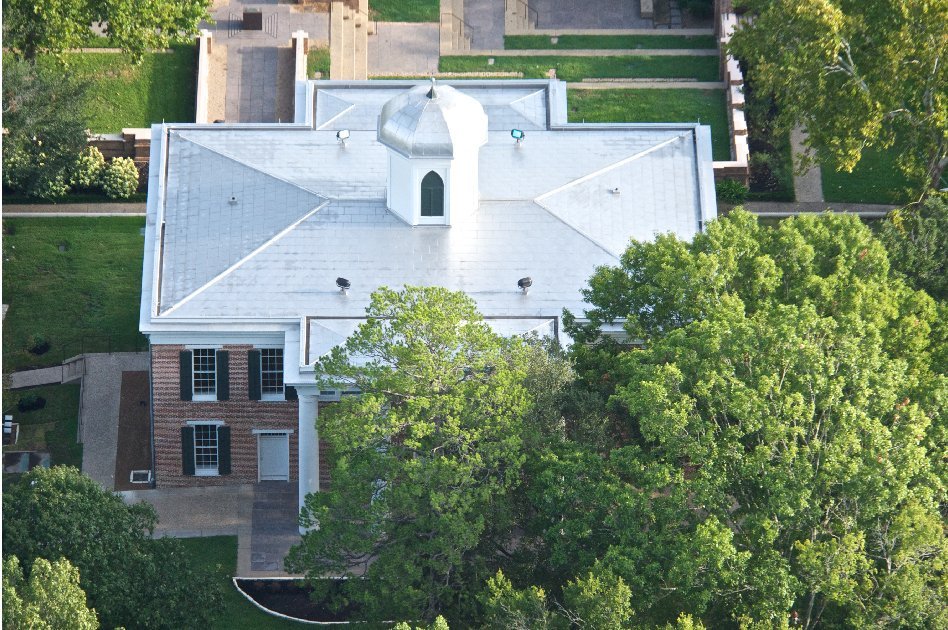Stainless Steel Roof is Perfect for Historic Renovation
Historic Austin Hall, which had not been renovated in twenty-seven years, is a state archeological landmark, and therefore requires approval from the state of Texas when undergoing restoration. The roof was among the improvements needed and InvariMatte® stainless steel, developed by Contrarian Micro Textures, was chosen in a unique form, creating an aged appearance using this cutting-edge stainless steel finish. While InvariMatte®’s crisp, low glare texture has found a home on modern buildings to create a uniform, high tech appearance, the roof panels on Austin Hall were fabricated and installed using traditional methods that were true to the period of the building. The result is a handsome, durable roof that looks like it was always there. Better still, since it is stainless steel it’s safe to say it will always be there in the future – a substantial maintenance savings.
Dedicated June 24, 1851, in Huntsville, Texas, Austin Hall is brick and mortar construction with walls that are sixteen inches thick. The decision to refurbish Austin Hall was under consideration for several years until funding could be found. Three foundations, Houston Endowment, Inc., The Brown Foundation, Inc., and The Elkins Foundation, contributed as well as businesses and alumni and with that support they were ready to proceed.
The renovation was lead by the Sam Houston State University Facilities Planning & Construction office. The committee led by Chad Huff, SHSU Facilities Architect selected Ford Powell Carson, San Antonio, Texas for the project with their preservation expertise in mind.
Austin Hall was deteriorating on the outside due to water erosion and exterior cracks. In addition to the new roof, the floors and windows needed to be refurbished, the cupola required restoration, new electrical was necessary including HVAC and the plumbing had to be addressed.
To begin the project, Allison Chambers, Ford Powell Carson Architect visited Austin Hall and determined the issues, what caused them and the appropriate solution. “It is rehabilitation when preservation is involved, that is repairing or fixing what is broken. When restoring the masonry it was discovered that the wood lintels had rotted out. The solution was to reinforce the lintels with stainless steel with the wood becoming a decorative finish,” explained Ms. Chambers.
Decisions that respected the historic period of the building needed to be made. A primary goal was to minimize maintenance. A suggestion was made to coat the existing roof, but SHSU wanted to replace it, so they chose stainless steel. The existing roof was copper. The Frank Brown Roofing Company had the experience and knowledge to fabricate the InvariMatte® stainless steel. They sheared the metal and formed the panelized system that comprises the roof. A crew of six to eight people worked for six to eight weeks to build the roof. “I’ve done roofing my whole life and while it was a lot of work, it turned out well and it’s a good product that should last indefinitely,” explained Frank Brown.
The General Contractor was Whiting Turner with project management led by Anthony Terilli.
Austin Hall began as a Presbyterian College that later relocated to Sherman, Texas in 1874 because the International Great Northern Railroad bypassed Huntsville. Other issues had reduced enrollment, including a smallpox scare in 1864, yellow fever in 1867, the Civil War and in 1858 the faculty denied degrees to graduates because they held a graduation dance. However, the degrees were finally awarded the following year.
In 1877 the Methodist Church acquired Austin Hall but their plans never materialized and in 1879 the state’s first teacher’s college was established with assistance from the Peabody Education Fund. Dubbed a “normal school” the teacher’s college prospered. In 1881 Austin Hall’s cupola was removed to allow the addition of a third floor which was completed in the 1882-1883 academic year. In 1918 the curriculum expanded to four years. In 1923 the name was changed to Sam Houston State Teacher’s College.The third floor was removed in 1927 and the roof returned to its original design minus the cupola.
On February 12, 1982, there was a fire on campus in the gothic revival building, known as “Old Main,” built in 1888 it was located too close to Austin Hall. As a result Austin Hall caught fire severely damaging the roof. During the 1983-1984 restoration from the fire, Austin Hall was returned to its original grandeur with a new cupola. The outline of Old Main remains today, in the shadow of Austin Hall.Difficult as the loss of the building was, it left historic Austin Hall in its right place, that being with surrounding space that allows students and campus visitors to see Austin Hall as it was intended to be seen. The students have immortalized Austin Hall by etching their names on the bricks; care has been taken to ensure that history was not lost.
It was submitted for listing on the National Register of Historic Places – September 2012 and approved by the State Board of Review and now pending final approval from the National Forest Service.
